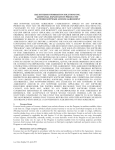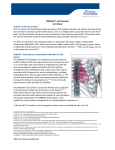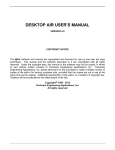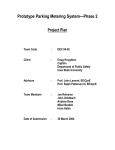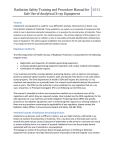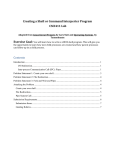Download INMOTION ARM™ - Interactive Motion Technologies
Transcript
INMOTIONARM ™ INTERACTIVE THERAPY SYSTEM Clinician’s Guide Release 1.0: September 2012 Interactive Motion Technologies 80 Coolidge Hill RoadWatertown, MA 02472 USA Phone: +1-617-926-4800 Fax: +1-617 926-4808 Sales: [email protected] Customer Support: [email protected] INTERACTIVE MOTION TECHNOLOGIES Redefining Recovery™ INMOTIONARM™ INTERACTIVE THERAPY SYSTEM Copyright © 2012 Interactive Motion Technologies. No part of this book may be reproduced, stored in a retrieval system, or transmitted in any form or by any means, electronic, mechanical, photocopying, recording, or otherwise, except as may be expressly permitted by the applicable copyright statutes or in writing by the Publisher. No license, express or implied, to any intellectual property is granted by this document. Publishing Information Document number: 2012-1 Release1.0 Date September 2012 This Clinical Guide is the result of clinicians’ and patients’ generous feedback and invaluable contributions from the Interactive Motion Technologies team - Ed Anderson, Carey Sue Barney, Susan Glasser, Rachel Grayson, Sharon Krebs, Hermano Igo Krebs, Rodolfo Rohr, Stan Sassower, and Andrew Tannenbaum. Thank you all. Brenda Hyland-Miller, M.B.A., Director of Clinical Services 2 InMotion ARM™ Clinician’s Guide — September 2012 INTERACTIVE MOTION TECHNOLOGIES Redefining Recovery™ Contents Purpose of the Clinical Guide.......................................................................................................................................7 Safe and Responsible Use.............................................................................................................................................7 General Information........................................................................................................................................................7 Robot Evaluation:..........................................................................................................................................................................8 Robotic Therapy:............................................................................................................................................................................8 Key Features of the InMotion ARM™ Robot.........................................................................................................................9 Section I Clinical Application...............................................................................10 Benefits of Robotic Rehabilitation...........................................................................................................................10 Benefits of Robotic Evaluation............................................................................................................................................... 10 Benefits of Robotic Therapy ................................................................................................................................................... 10 Candidates for Robotic Rehabilitation....................................................................................................................11 Indications for Robotic Therapy............................................................................................................................................ 11 Contraindications and Precautions...................................................................................................................................... 11 Section II Robot and Patient Preparation........................................................13 Prepare the Robot..........................................................................................................................................................13 Robot Configuration and Calibration.................................................................................................................................. 13 Disinfect Surfaces....................................................................................................................................................................... 14 Prepare the Workstation.......................................................................................................................................................... 14 Position the Patient .....................................................................................................................................................14 Sitting Position............................................................................................................................................................................ 14 Standing Position....................................................................................................................................................................... 16 Manage the Patient Record........................................................................................................................................17 New Patient Record................................................................................................................................................................... 17 Select an Existing Patient Record......................................................................................................................................... 18 Add a Clinician ID....................................................................................................................................................................... 18 Patient/Robot Introductions......................................................................................................................................19 Emergency Stop Instructions ................................................................................................................................................ 19 Introduce the Robot.................................................................................................................................................................. 19 Patient Practice............................................................................................................................................................................ 20 Section III InMotion Robot Arm Evaluation.....................................................23 InMotion ARM™ Evaluations Tests............................................................................................................................23 InMotion Kinematic Tests ....................................................................................................................................................... 23 InMotion Kinetic Force Test ................................................................................................................................................... 24 Conducting the Evaluation ........................................................................................................................................24 InMotion ARM™ Clinician’s Guide — September 2012 3 INMOTIONARM™ INTERACTIVE THERAPY SYSTEM Section IV InMotion Evaluation Reports and View Plots..........................................................................................31 InMotion Evaluation Reports.....................................................................................................................................31 Arm Evaluation Report............................................................................................................................................................. 31 Arm Progress Report................................................................................................................................................................. 32 Arm Log Data Report:............................................................................................................................................................... 34 View Results on Screen.................................................................................................................................................34 View Point-to-Point Tracings.................................................................................................................................................. 35 View Circle Tracings .................................................................................................................................................................. 36 View Round Dynamic Tracings ............................................................................................................................................. 38 View Shoulder Tracings ........................................................................................................................................................... 39 Section V InMotion ARM™ Evaluation Measures...........................................41 InMotion Evaluation Measures from the Point to Point Test..........................................................................................................................................................41 InMotion Smoothness Measure:........................................................................................................................................... 41 InMotion Reach Error Measure: ............................................................................................................................................ 41 InMotion Mean Velocity Measure: ....................................................................................................................................... 41 InMotion Max Velocity Measure: .......................................................................................................................................... 42 InMotion Path Error Measure: ............................................................................................................................................... 42 InMotion Evaluation Measures from the Circle Test..........................................................................................42 InMotion Circle Size Measure: ............................................................................................................................................... 42 InMotion Joint Independence Measure: ........................................................................................................................... 43 InMotion Evaluation Measure from the Playback Static Test ...............................................................................................................................................45 InMotion Hold Deviation “Stabilization” Measure ......................................................................................................... 45 InMotion Evaluation Measure from the Round Dynamic Test Measure: .................................................................................................................................46 InMotion Displacement Measure: ....................................................................................................................................... 46 InMotion Evaluation Measures from the Shoulder Tests .........................................................................................................................................................47 InMotion Maximum Force Measures: ................................................................................................................................. 47 Section VI: InMotion Robotic Therapy...............................................................49 “Train the Brain” Treatment Approach....................................................................................................................49 Motor Learning Principles....................................................................................................................................................... 50 InMotion Robotic Therapy..........................................................................................................................................50 Frequency and Duration of Treatment............................................................................................................................... 51 Treatment Considerations....................................................................................................................................................... 51 4 InMotion ARM™ Clinician’s Guide — September 2012 INTERACTIVE MOTION TECHNOLOGIES Redefining Recovery™ Section VII Therapy Protocols and Treatment Tools..............................................................................................52 Locating Treatment Protocols................................................................................................................................................ 52 Before Starting Treatment ...................................................................................................................................................... 53 InMotion Therapy Protocols ......................................................................................................................................54 Planar Adaptive Protocol......................................................................................................................................................... 54 Planar Composite Protocols................................................................................................................................................... 57 Pediatric Protocols..................................................................................................................................................................... 60 Section VIII Exercise Games....................................................................................60 Section IX: Improving Patient Performance....................................................65 Patient Performance Feedback ................................................................................................................................65 Performance Metric Summary..................................................................................................................................67 Section X InMotion Therapy Reports.................................................................68 Therapy Notes Report:..................................................................................................................................................68 Utilization Report:..........................................................................................................................................................68 Section XI: Producing InMotion ARM™ Reports.............................................69 Calculate Reports:..........................................................................................................................................................69 Show Reports...................................................................................................................................................................69 Copy Reports to Removable Media: .......................................................................................................................69 Remove the Flash Drive from the Robot. Printing Reports from the Flash Drive....................................70 Removing Files from the Flash Drive................................................................................................................................... 70 Report Help......................................................................................................................................................................70 Print Screen......................................................................................................................................................................70 Section XIi InMotion HAND™ Robot....................................................................71 Attach the Hand Robot................................................................................................................................................71 Removing a Hand Robot ............................................................................................................................................73 Configure and Calibrate the Hand Robot .............................................................................................................74 Positioning the Hand....................................................................................................................................................75 Section XIII: InMotion HAND™ Treatment Protocols ...................................76 Test.......................................................................................................................................................................................76 Hand Close........................................................................................................................................................................76 Hand Stretch....................................................................................................................................................................76 One-Way-Record Grasp...............................................................................................................................................76 Grasp Adaptive................................................................................................................................................................76 InMotion ARM™ Clinician’s Guide — September 2012 5 INMOTIONARM™ INTERACTIVE THERAPY SYSTEM One Way Record Reach................................................................................................................................................76 Reach Adaptive...............................................................................................................................................................76 One Way Record Pick.....................................................................................................................................................77 Pick Adaptive...................................................................................................................................................................77 Section XIV InMotion HAND™ Performance Feedback..........................................................................................78 Section XV - Operating the Robot.......................................................................79 Before You Begin.............................................................................................................................................................79 Stopping the Robot................................................................................................................................................................... 79 Warnings........................................................................................................................................................................................ 79 Turn the System On:......................................................................................................................................................80 Turn the Robot On.........................................................................................................................................................81 Calibrating (Zero) the Robot......................................................................................................................................82 Pause the Robot..............................................................................................................................................................84 Enable or re-start the Robot (power is on) ...........................................................................................................84 Turning the Robot Off...................................................................................................................................................85 Raw Data ...........................................................................................................................................................................85 Section XVI: Basic Troubleshooting...................................................................85 System Not Working .....................................................................................................................................................85 Bad Calibration................................................................................................................................................................86 The Robot Arm Doesn’t Move....................................................................................................................................86 The Monitor Resolution is Wrong.............................................................................................................................86 Section XVII Customer Service .............................................................................86 Appendix A: Quick User Guide Arm.......................................................................87 6 InMotion ARM™ Clinician’s Guide — September 2012 INTERACTIVE MOTION TECHNOLOGIES Redefining Recovery™ Clinical Guide Purpose of the Clinical Guide The Clinical Guide is intended to serve as a reference and resource guide for clinicians using the InMotion ARM™ and Hand Robot to evaluate and treat patients with neurological conditions. Clinicians have the skills, knowledge and judgment necessary to customize the assessment and treatment to meet the individual needs of each patient. This manual is a resource for clinicians trained to use the InMotion ARM™ and Hand Robot. Safe and Responsible Use InMotion Robots are tools intended to promote recovery following a neurological or musculoskeletal injury. The physician and therapist can best evaluate how to integrate these medical devices into the process of rehabilitation. The attending physician and therapist must consider the potential benefits and risks before employing InMotion Robots. Rehabilitation is an evolving field and the physician and therapist must keep current with the state-of-the-art and advances in rehabilitation to best balance benefits and risks when developing an individualized treatment plan. Clinicians are ultimately responsible for clinical decision-making, patient safety and appropriately using the InMotion ARM™ Robot in accordance with the InMotion User Manual and Clinical Guide. Failure to do so may compromise patient safety, diminish outcomes and damage the equipment. The InMotion Robots have been approved for clinical use in a number of countries. While we will continue to apply and seek a global coverage, you should consult with IMT to confirm InMotion robots have received approval for use in your country. Nothing in this Clinical Guide should be considered a solicitation or promotion, or a recommendation for use, which is not authorized, by the local laws and regulations. For more information about the system and its operation, refer to the InMotiontm Arm Robot User Manual. General Information InMotion robots are evidence-based technology used by clinicians invested in adopting proven best practice. Clinicians use the InMotion ARM™ Robot for evaluation and treatment of patients with upper extremity movement deficits resulting from a neurological or musculoskeletal condition. The InMotion ARM™ Robot is a sensitive measurement tool ideally suited to evaluate motor control and movement recovery. It is also a “smart” treatment tool that adapts to the patient’s movement by adapting and providing assist-as-needed exercise guidance. Researchers at Massachusetts Institute of Technology (MIT) developed the InMotion ARM™ Robot’s unique adaptive, interactive robotic technology. Researchers around the world use the InMotion Robots (aka MIT Manus) to gain insight into motor control and movement recovery. There is more than 20 years of research in more than 80 peer review publications and over 1000 stroke patients that have participated in clinical trials that shows the real results InMotion Robots can bring to the patient. InMotion ARM™ Clinician’s Guide — September 2012 7 INMOTIONARM™ INTERACTIVE THERAPY SYSTEM Robot Evaluation: The InMotion Evaluation is a powerful and efficient assessment tool. The robot is a sensitive, precise measurement instrument that calculates a new set of motor control measures (InMotion Evaluation Measures). Clinicians for the first time can efficiently (in about 20 minutes) and reliably quantify motor control and measure movement recovery in patients with severe to moderate upper extremity movement impairments. The InMotion Evaluation measures are highly correlated with performance on the Fugl-Meyer, NIH Stroke Scale and Motor Power tests. In other words, InMotion evaluation measures are highly correlated with real upper extremity function. Robotic Therapy: Intensive, interactive robotic therapy is an effective, evidence-based treatment approach adopted by rehabilitation clinicians worldwide. Published research demonstrates that patients with severe to moderate upper extremity impairments (motor and sensory) resulting from neurological conditions may make significant improvements in movement and function. Veteran Affairs Randomized Controlled Clinical Trial Utilizing InMotion Robots: “Robot-assisted therapy for long term upper limb impairments after stroke.” NEJM April 18,2010. Secondary outcomes, patients receiving robot-assisted therapy, as compared with those receiving usual care, had significant improvement in motor function and social participation at 12 weeks, as measured on the Stroke Impact Scale. “ We have shown that with the right therapy [patients] can see improvement in movement, everyday function and quality of life – this is giving stroke survivors new hope. ” Albert Lo, lead investigator for “Robot-Assisted Therapy for Long Term Upper Limb Impairments after Stroke” NEJM April 18, 2010 8 InMotion ARM™ Clinician’s Guide — September 2012 INTERACTIVE MOTION TECHNOLOGIES Redefining Recovery™ Key Features of the InMotion ARM™ Robot Universal Design & Ease of Use hh Accommodates small and large body types hh Adjustable height for training in sitting and standing hh Software activities customized for pediatric and adult populations hh “Grab and Go” - minimal adjustments needed to “fit” the patient The InMotion Evaluation measure shoulder/elbow kinematic control, kinetic force and movement recovery. hh 5 InMotion Evaluation Tests hh 13 InMotion Evaluation Measures hh Evaluation Reports that display results in graphic and numeric formats hh Progress Reports compare InMotion evaluation measures for a series of evaluations. Treatment Protocols allow clinicians to customize individual treatment plans hh Evidence-based protocols hh Performance feedback metrics hh More than 25 protocols »» Adaptive, Static, Resistive, Orthogonal Gain, Perturbation »» Interchangeable, progressive, customize treatment planning »» Pediatric and adult protocols hh Treatment Reports Therapeutic Exercise Games for hh Motor planning and eye-hand coordination hh Attention hh Visual field deficits/neglect hh Massed practice Hand Robot hh Gross grasp and release training hh Integrated reach (shoulder/arm) with grasp and release (hand) movements hh Removable InMotion ARM™ Clinician’s Guide — September 2012 9 INMOTIONARM™ INTERACTIVE THERAPY SYSTEM Section I Clinical Application Benefits of Robotic Rehabilitation Benefits of Robotic Evaluation The InMotion ARM™ Robot is ideal for evaluating patients with upper extremity movement impairments resulting from a neurological condition. InMotion Robot Evaluations help clinicians quantify motor control and document movement recovery. The robot can accurately and reliably be used to 1) establish baseline measurements before initiating treatments, 2) measure progress at periodic intervals and 3) measure outcomes at the end of a series of treatments. Clinicians use the InMotion ARM™ Robot to evaluate the effects of robotic therapy as well as other treatment approaches or therapeutic interventions. Clinicians are incorporating the InMotion Robot Evaluation as part of their comprehensive neurological evaluation even for patients receiving other types of interventions. Benefits of Robotic Therapy With more than 20 years of research, 80 peer-review publications and 1000 patients in clinical trials, robotic therapy using the InMotion Robot is a proven evidence-based therapy and technology. Researchers cite as possible explanations: hh Repetitive exercise may evoke and enhance a neuro-plastic recovery process, whereby new neural pathways replace some of the neural pathways lost due to brain injury. hh The continuously interactive nature of robotic therapy ensures patient participation by assisting only as needed. hh The adaptive capabilities of robotic therapy adjust the degree of challenge and robotic assistance to accommodate each patient’s individual needs and present abilities. hh Number of movements provided by the robot far exceeds any dosage that might be administered by a human therapist. hh Beneficial coupling of movements with sensory information: from both the visual display and the robot arm itself ensures all movements are successful due to the robot assistance; and prevents the brain from experiencing grossly inappropriate responses to its motor commands. 10 InMotion ARM™ Clinician’s Guide — September 2012 INTERACTIVE MOTION TECHNOLOGIES Redefining Recovery™ Section VI: InMotion Robotic Therapy The InMotion robots have the unique ability to adapt to a patient’s arm movements. During robotic therapy the robot provides the patient with assistance-as-needed and automatically adjusts the level of challenge the patient experiences. InMotion robots “feel” gentle because of the patented interactive low impedance technology engineered into each InMotion robot. Both the American Heart Association and the VA/DoD have endorsed upper-extremity robot-mediated rehabilitation therapy for stroke care. “Comprehensive Overview of Nursing and Interdisciplinary Rehabilitation Care of the Stroke Patient: A Scientific Statement from the American Heart Association” which assigned InMotion upper extremity robotics the highest Classification of Recommendation and Level of Evidence for stroke patients in outpatient and chronic care settings. The publication stated that for stroke patients in acute inpatient settings, upper extremity robotic is a recommended treatment, although there is some conflicting evidence. Published in 2010. The Department of Veterans Affairs, Department of Defense and American Heart Association/ American Stroke Association recommends that clinicians provide upper extremity robotic therapy to eligible patients in their 2010 publication “VA/DoD Clinical Practice Guidelines for Management of Stroke Rehabilitation” Rehabilitation clinicians worldwide are integrating robot evaluations and robotic therapy to improve outcomes in patients with severe to moderate upper movement impairments. For a Bibliography of Research using the InMotion Robots, contact IMT customer service. Adaptive, interactive robotic therapy employs the principles of motor learning and scientific evidence to gain movement recovery. Patients are actively engaged, express movement; perform high intensity repetition (+1,000s of repetitions per session), receive assistance-as-needed (“good” sensory motor feedback), and objective performance feedback with the InMotion ARM™ robot. According to a study published by the New England Journal of Medicine in April 2010, InMotion robots are safe and cost effective based upon findings from a large multi-site study conducted by the Veterans Administration. “Robot-Assisted Therapy for Long-Term Upper-Limb Impairment after Stroke” “Train the Brain” Treatment Approach “Train-the-Brain” is the new focus for rehabilitation professionals working with patients with neurological conditions. Whereas, musculoskeletal therapists treatments and interventions are focused on muscles, bones, joints, tendons, and other peripheral anatomical structures, neuro therapists focus on “ training the brain.” InMotion robots are the most effective and evidence based treatment tools available for clinicians to provide intensive, interactive upper extremity movement training for patients with severe to moderate impairments. InMotion ARM™ Clinician’s Guide — September 2012 49 INMOTIONARM™ INTERACTIVE THERAPY SYSTEM Motor Learning Principles InMotion robotic therapy is based upon motor learning principles. Clinicians using robotic therapy should be familiar the principles of motor learning. 1. Use it or Lose It: Lack of use can degrade bran function and may lead to further loss of function 2. Use it and Improve It: Motor skill training and practice can increase plasticity within the cerebral cortex 3. Specificity: The type of activity is essential. Movement training must be task-specific, meaningful, adaptive and challenging. Example learning to play a guitar. 4. Repetition is Crucial: Practice, Practice, Practice. Increased stimulation increases recovery, Talent is over-rated. 5. Intensity is Key: High intensity drives motor recovery, but start slow during the first few weeks after injury and progress based on a patient’s tolerance. 6. Timing Matters: Earlier is better, but it is never too late to learn to move. Don’t wait for self-taught compensatory behaviors to become established. 7. Specific, Goal-oriented Targets: Self-selected, well-defined goals plus performance feedback leads to movement self-regulation. 8. Age and Experience Counteract: Greater physician and mental activity can counter cognitive decline associated with age. Enriched environments enhance recovery. 9. Transference Travels: Exercise creates a “good buzz” of activity in the brain. 10. Interference Impedes: Distractions, too many instructions and interruptions can interfere with the motor learning process. Create a situation that helps the patient focus. InMotion Robotic Therapy InMotion robots are designed to meet the following conditions for motor learning. 50 1. Active effort: A patient must actively “send a message” to move the arm. InMotion robots allow patients to express movement, passive movement does not stimulate motor recovery. 2. Sensory Motor Message: The brain must receive a “good quality” sensory motor message that communicates that the arm knows how to move. In a way, the robot’s “assist as needed” tricks the brain into thinking the arm knows how to move. 3. Intensive Practice: High intensive repetitions are required to stimulate motor learning. A treatment session must be based on a patient performing about 1,000 repetitions. Less than 400 repetitions do not demonstrate changes in the brain. InMotion ARM™ Clinician’s Guide — September 2012 INTERACTIVE MOTION TECHNOLOGIES Redefining Recovery™ Frequency and Duration of Treatment A typical course of interactive-robotic therapy is 18 to 36 sessions consisting of a 1-hour treatment session 2 or 3 times per week for a period of six to 18 weeks. A patient performs 1024 movements per session. Many patients continue to make gains beyond the six to eighteen weeks period tested during clinical trials, thus continuation of therapy may be as indicated by the patient’s progress. Research does not tell us when a patient’s recovery will plateau or end. Clinicians must assess each patient’s progress and advocate for continuation of treatment when progress is being made. Treatment Considerations Inpatient or Outpatient: Patients in an acute setting will benefit from intensive robotic therapy, even if they cannot tolerate a full hour of robotic therapy everyday or the schedule limits their time on the robot. Introducing patients to robotic therapy in the acute phase and arranging for outpatient follow-up is a realistic and effective treatment plan. Distal to Proximal: Patients’ develop and recovery upper extremity motor control from proximal (shoulder) to distal (hand). Research with the InMotion robots supports a distal to proximal training approach. Intensity: If 1 hour of intensive robotic therapy stimulates recovery, will 2 hours per day increase recovery results? One hour is enough; the brain needs time to process the information, a sleep cycle is desired before the next session. Alternate Robots: Is it better to split the time on the same day between the arm and the hand robot, or is it better to alternate robot? Better results occur when only a single robot per day is used. Stay the Course: It is better to do fewer activities and more repetitions. It is better to utilize the same protocol for each therapy session and throughout the course of treatment, than to switch between activities and spend less time on each on. The “Therapy” protocol using the adaptive Clock game is the best choice, other protocols or games may be substituted, but completing 1024 repetitions of the same activity must be preserved to ensure gains in motor recovery. Progression: There is strong evidence that progression to a Hand or Wrist robot after completing an arm robot therapy course can result in continued gains in upper extremity function and then progressing a second or third robot has been demonstrated to improve movement recovery and function. Improvements: During research studies, subjects usually gained more than 3 point on the Fugl-Myer, an upper extremity function test, and a six-point gain was not unusual. Gains of 3 or more points on the Fugl-Meyer test are considered functionally significant and can impact a person’s ADL independence. Patient may gain +3 points with each additional robot used. Improvements in the InMotion motor control metrics are highly correlated with improvements on the Fugl-Meyer test. In other words, training on the InMotion robot translates into gains in function. InMotion ARM™ Clinician’s Guide — September 2012 51













